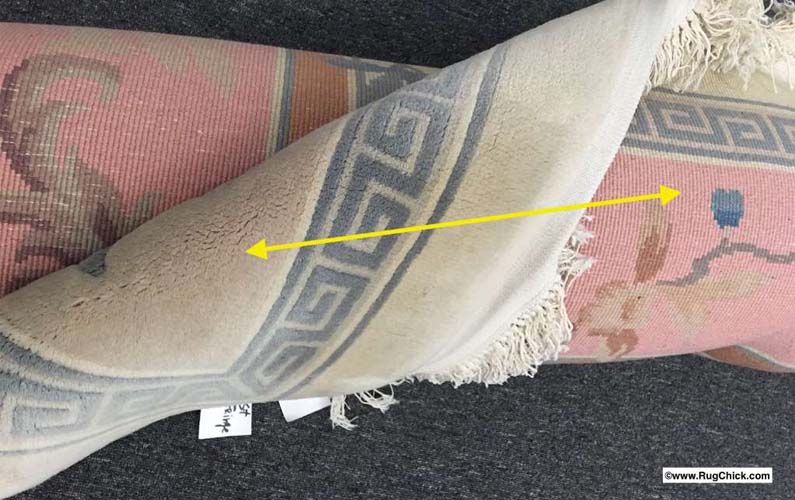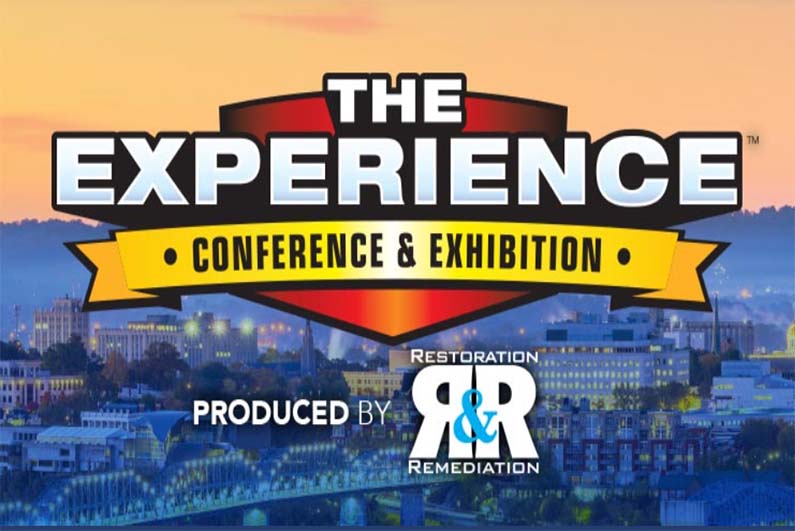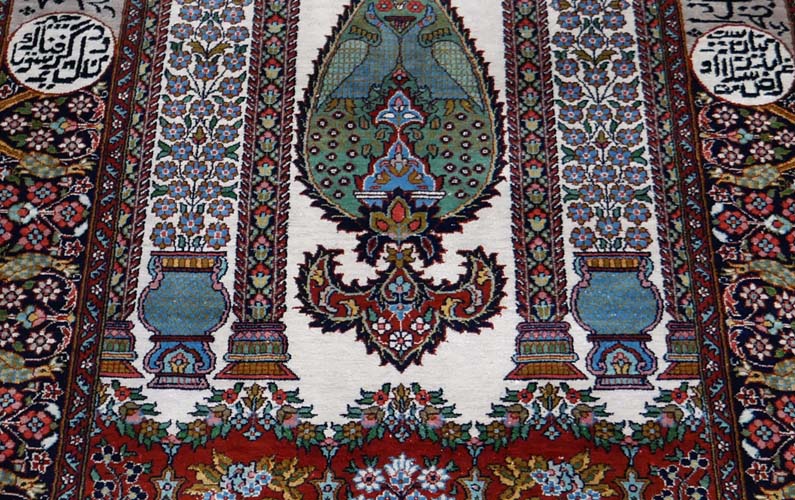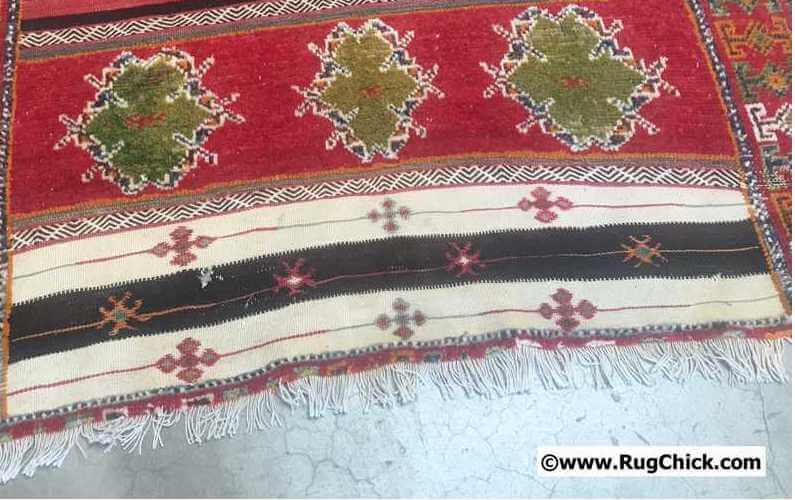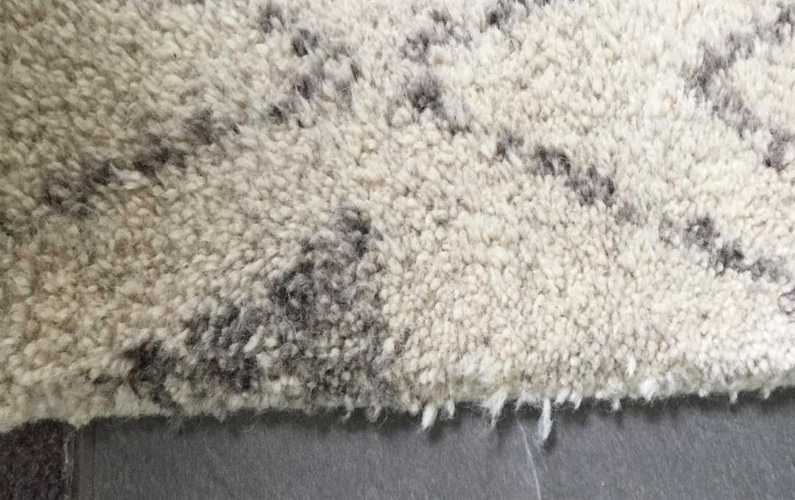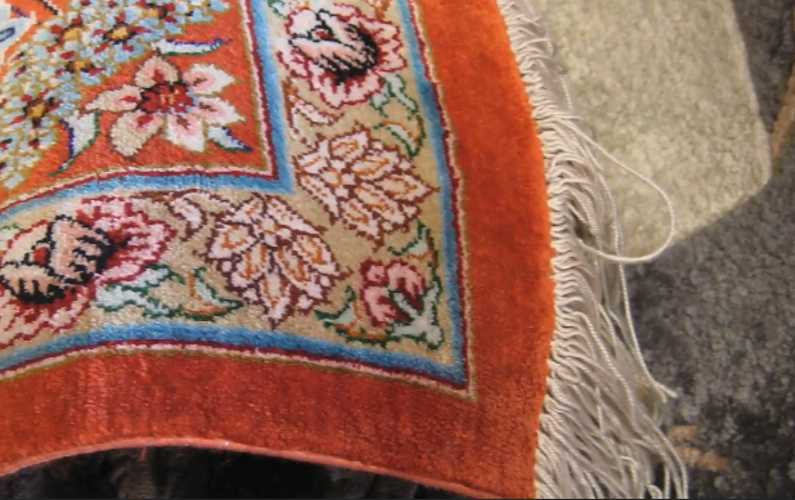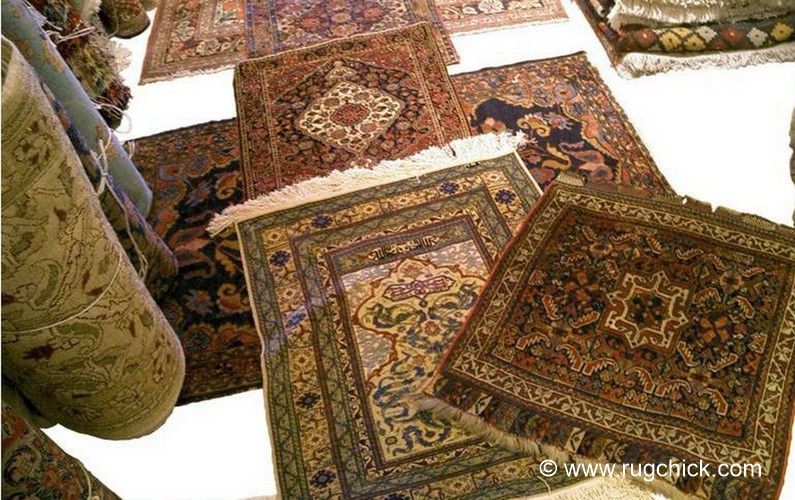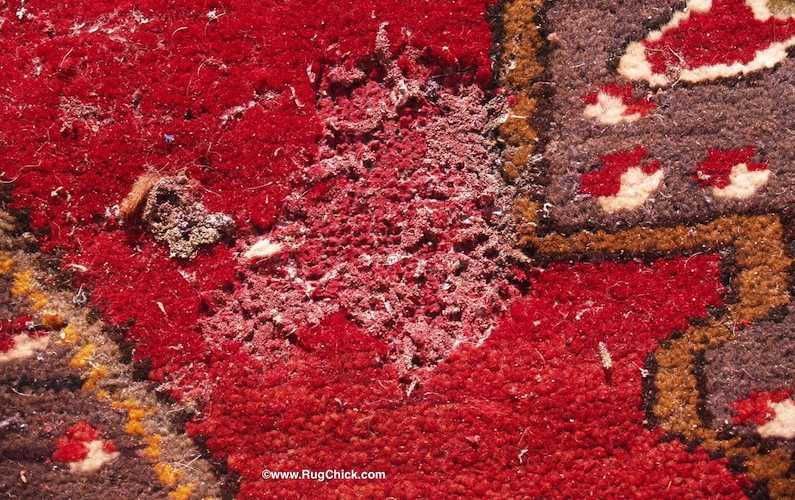Afghan rugs, the trade-off for new tribal rugs.
Rugs are loosely lumped into two general categories – “tribal” rugs or “city” rugs.
City rugs come from “bigger” weaving operations that tend to produce rugs with more intricate designs, higher knot counts, and tighter quality control. This is a broad generalization of course.
Tribal rugs come from smaller operations, or nomadic weavers who weave as they travel. They tend to have designs that are a bit cruder, with sharper edges instead of curvilinear designs. (FYI – in a future post I will explain why you see this curvilinear versus geometric difference, it’s related to the warp and weft construction and knot type.)
I’ve seen many beautiful “city” rugs in my lifetime…
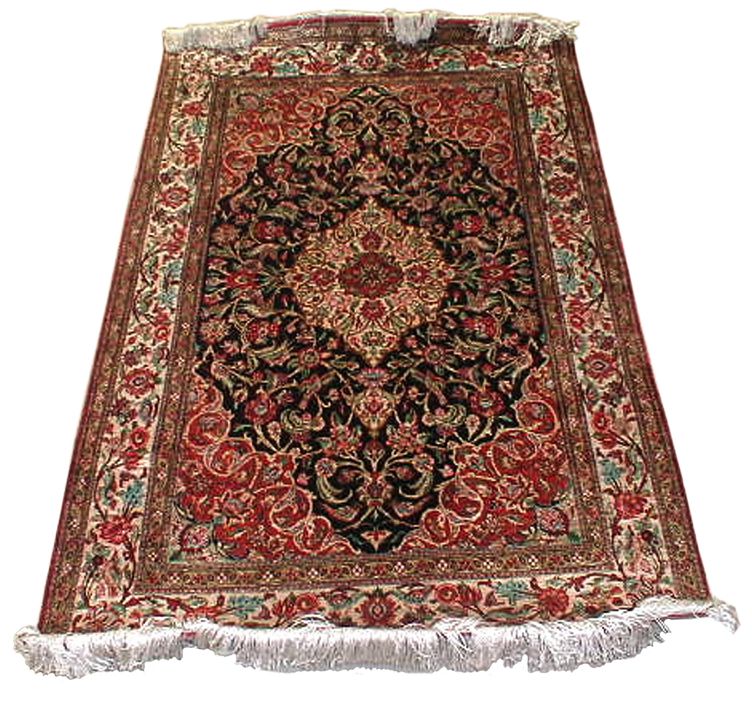
Beautiful silk “city” production rug.
…elaborate designs, vivid colors, and a fine weave that makes them almost perfectly symmetrical.

Very finely woven Turkish Hereke silk rug.
Though I have a real appreciation for the “city design” pieces…
…when it comes right down to it, I like the tribal pieces more!
They are cruder at times, usually utilizing weaving techniques that make them have more of an “etch-a-sketch” type design than the beautiful floral illustrations shown up above…
…but I like the more geometric – and strong – style.
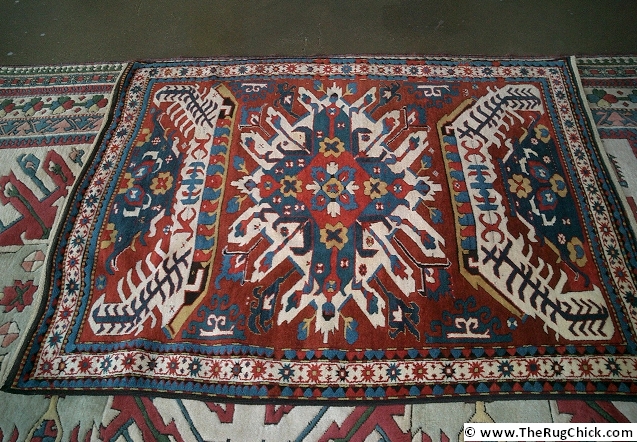
Great old Kazak (woven in Caucasus Mountain region)
I just love the tribal design pieces. To me they have more “character” and personality. If they are made with natural (“vegetal”) dyes they are very vibrant, with a lot of texture and depth to their look. And the older ones have such a fantastic luster to them.
I mean, just LOOK at this incredible piece here:
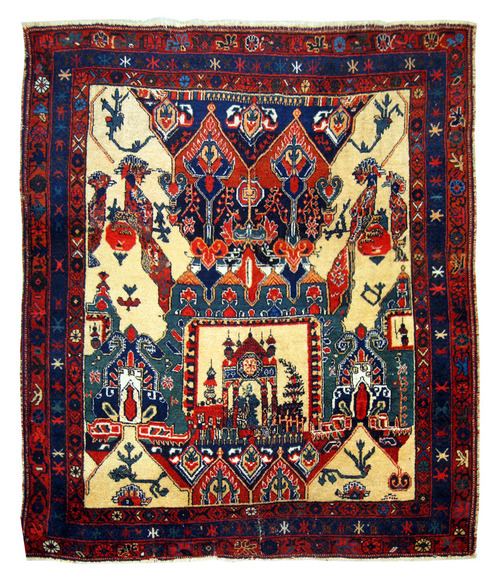
Gorgeous old Afshar rug.
Whether they are rugs from the Caucasus region, the Persian tribal weaving regions, the Baluchi tribal pieces, the Tibetan and Nepalese pieces, or even American Indian weavings – I am drawn to these typically smaller, cruder, but much more “energetic and alive” (to me) textiles.
I really feel like these are a piece of someone’s life – and heart – that now has become part of my life. Old textiles become new friends of those who love rugs.
That said – just like with “real” friends – there are some “personality quirks” that can come along for the ride.
“Oh your rug has a GREAT personality!” (aka the “quirks” are charming…)
Quirks, which in newer rugs – in particular coming from Afghanistan – can result in some trade-off’s that might unsettle those who are looking for a perfectly designed rug.
This is especially due to two factors in that region, one being the war’s impact on resources and consistent commerce, and another being their “tradition” of weaving wool on wool rugs (versus wool woven on a cotton foundation).
Of course, before cotton became “king” wool rugs were all woven on wool warps and wefts. The use of cotton allowed for the creation of larger, flatter, more symmetrical rugs because the cotton can be spun into smoother stronger strands for use as warps and wefts versus wool which when spun has more variation in thick and thin areas.

Hand spun Merino wool varies in thickness.
Wool is an exceptional fiber, in fact, the best rugs to buy today are wool rugs, in my opinion. They are super durable, can be vibrantly dyed, are naturally fire-resistant, and are the truly renewable resource (grows back year after year on sheep).
Where the wool face fibers can be sheared to create an evenly piled rug, when you are using wool as the warps and wefts of a rug – the “skeleton” of the rug – there are “quirks” that come about in the form of unevenness, buckling, creases, and sometimes shrinking if the wool had not been thoroughly washed and scoured before being spun.
In the industrialized countries wool processing and scouring is a serious operation, which cannot be duplicated as consistently and “aggressively” in tribal areas…
…especially war-torn tribal areas like Afghanistan.
So the trade-off for an authentic tribal piece from this region will be some quirks like these:
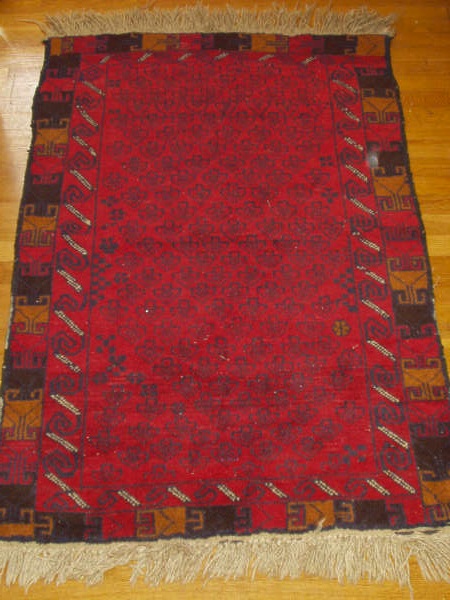
An uneven shape. Perfectly symmetrical is NOT an option.
On smaller rugs, the tribal characteristics are “cute.” If the rug is a few inches wider along one end than the other, it’s not a big deal. But when LARGER rugs are woven with that same varying tension and technique, the “quirks” can become more of a distraction than charming.
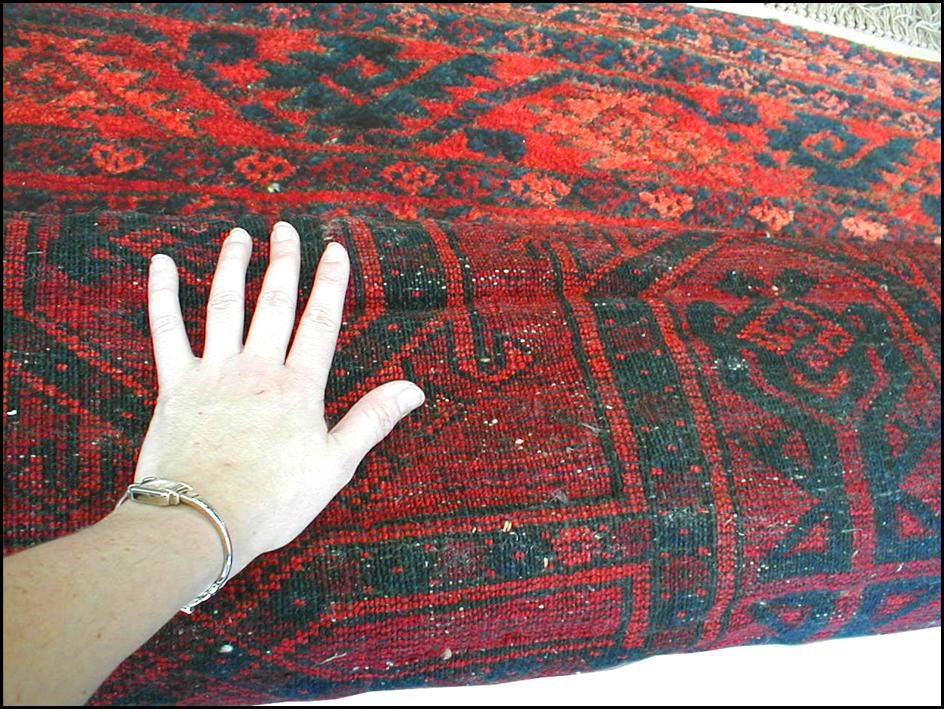
Creases in the weave seen on the back. This can make the top side have small “waves.”
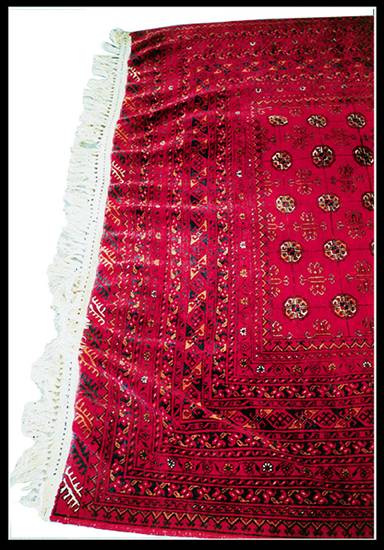
Uneven tension along the end created a big buckling problem.
Also due to the lack of the aggressive rinsing/scouring you can see an additional “quirk” of excess dye in the wool that can migrate (“bleed”) when the rug gets wet.
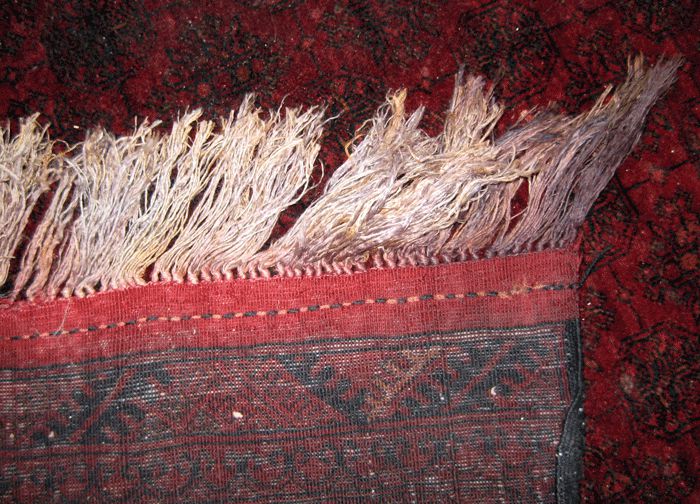
Afghan rug in a flood – red bled into the fringe.
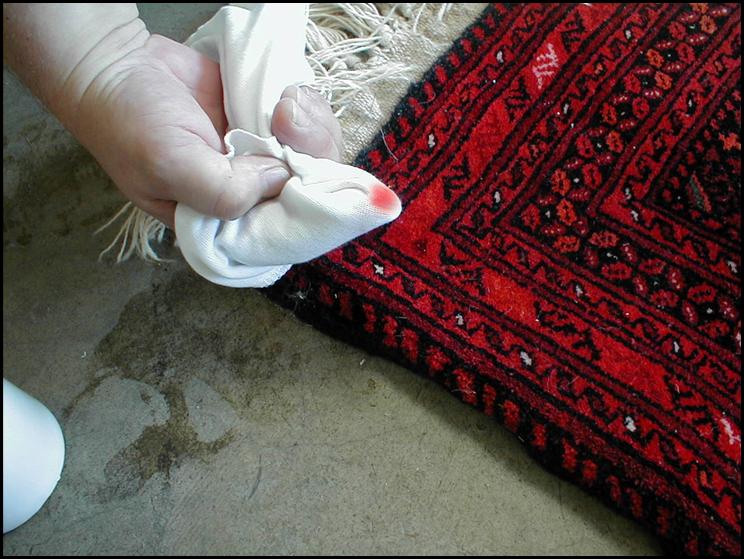
Dye test shows this rug is not colorfast. A tricky wash that requires a rug pro.
Some buyers of tribal rugs want to make them “perfect” – but that is not unlike being born with one foot a bit bigger than the other (we all have one!) and expecting someone to “fix” that for you.
The variations with your friends, from size to freckles to goofy smile, is what give them their unique – and PERFECT – personality.
It’s not different with rugs. The tribal ones have more “character.” And just as with people, it is REALLY hard to “change” who you are. It’s equally very difficult to undo the natural characteristics of rugs.
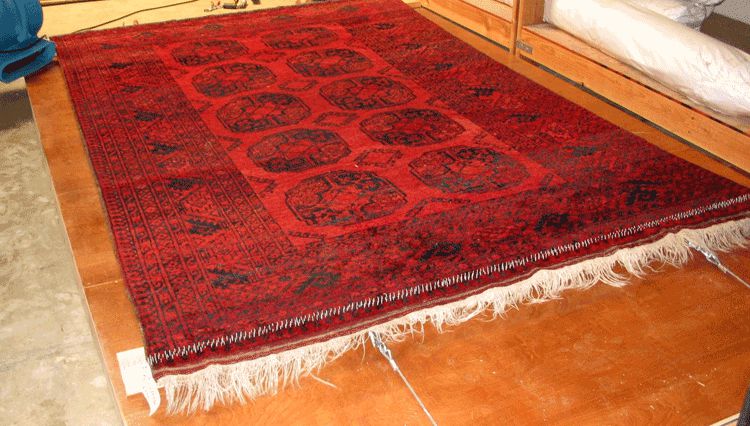
An attempt to STRETCH an uneven Afghan rug more flat.
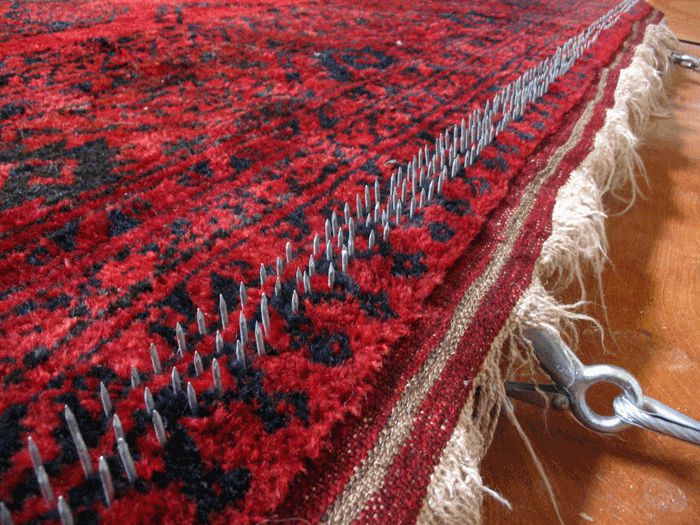
Aggressively trying to “undo” weaving flaws that made the rug buckle.
Afghan Tribal Rugs: What to remember.
When looking at Afghan rugs, whether to inspect for cleaning, or to inspect for buying, just a few things to remember.
– Any visible “quirks” – such as buckling, creasing, curling – will become more prominent with its first cleaning. (If the rug has been washed in the past, then this will not be a problem if the rug cleaner is properly trained.)
– Any strong dye migration that transfers with the dye test means that the wool used in the production was not thoroughly washed prior to production, so if the rug is woven on wool warps and wefts, you need to expect more unevenness due to stretching or shrinking over time. If it’s a small rug you may not notice, because the tension will be fairly even. But larger pieces, having used multiple weavers over a much longer time, may result in a rug that is not as smooth to the floor as you’d like (if you are purchasing).
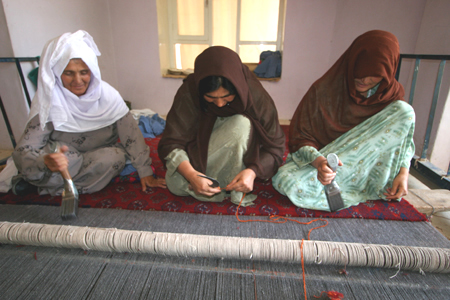
Afghan rug weaving project for women.
There are some beautiful rugs coming out of Afghanistan today. A few are highlighted on Emmett Eiland’s website on contemporary rugs. There are also several important weaving projects in the region empowering locals with a livelihood that I personally like to support.
But just as when a friend gives you some pottery she has made for you, and it’s not perfect, but you love it anyway – I look past any of the quirks in anything hand crafted that I get to have come into my life.
I’m not suggesting that all Afghan tribal rugs have some of these extreme “quirks” I have shown in this post’s photos. What I am saying is that ALL OF THEM will have variations in shape and size. Without a doubt, none will be perfectly rectangular, and none will lay perfectly flat on the floor.
The weaving of wool on wool will make these particular pieces prone to buckling, creasing, and more so when initially cleaned. Most times this will be very slight. The severe times will be evident at the time of purchase. You will see warning signs beforehand. None of these examples I shared here were “problems” that creeped up over time. The flaws were evident to begin with to a trained eye.
If you have a keen eye – as a buyer or a cleaner – you can avoid being surprised by inspecting the front and back sides carefully.
And if you are an owner of an Afghan rug, make sure you use a professional for the cleaning, because a D-I-Y cleaning on new tribal rugs might make your new purchase a ruined one if you are not careful.
I do not expect tribal rugs to be perfect. That’s what makes them “perfect” to me. I like quirks!
– Lisa


